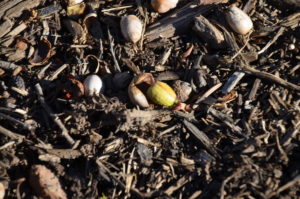Acorns are nuts that form on mature oak trees (Quercus spp.). Acorns come in many shapes, sizes and colors, depending on the species. An acorn is a single nut encased in a hard shell by a cap (used to identify what oak species it is). For example, Northern Red Oak (Q. rubra) tree produces egg-shaped acorns and are supported by shallow, saucer-shaped cup. White oak (Q. alba) produce acorns that are stubby and covered with warty cups.
Some oak species produce acorns almost every year, while on others acorns two years to mature. Older mature oaks, usually past 20 years old, produce many more acorns, and 70 or 80 year old trees can potentially produce thousands of nuts.
Many animal species rely on acorns as a food staple, such as squirrels, woodpeckers and deer (termed “mast”). Humans consume roasted acorns; right off the tree acorns are full of tannins, which can be toxic if eaten in high amounts. Acorns from the white oak group are low in tannin and have a nutty flavor when lightly roasted before grinding. Many acorns, cached away by squirrels and bluejays, will eventually germinate and become the next generation of oak forest.
Within its hard shell, an acorn contains one seed. The oak seed must not dry out or it will not germinate. To prevent drying, tree growers will collect and store acorns in plastic bags in the refrigerator for planting late next spring. Acorns need 1,000 hours of dormancy in low temperatures (33-37 º F). The larvae of some moths and weevils also live in acorns, consuming the kernel as it develops. These pests may consume more than 95% of all acorns in some years.
Acorns are rich in large amounts of proteins, carbohydrates, fats, vitamins, as well as the minerals such as calcium, magnesium, phosphorus, and potassium. Do not permit grazing animals to eat large amounts of acorns from specific Quercus species, especially red oak group and English oak (Q. robur).
Acorns of the white oak group typically start rooting as soon as they come in contact with the soil (in the fall). For example, bur oak (Q. macrocarpa) acorns fall from the tree from August to November. Germination usually occurs rapidly after seed fall, and favors root growth first. The taproot penetrates deeply into the soil. Contrarily, acorns from the northern red oak group drop in late fall, remain dormant through winter, and germinate in the spring.
These oaks are designated as “State Trees”:
White oak (Q. alba) – state tree of Connecticut, Illinois, and Maryland
Live oak (Q. virginiana) – Georgia state tree
Northern Red oak (Q. rubra) – New Jersey state tree
Bur oak (Q. macrocarpa) – Iowa state tree
Scarlet oak (Q. coccinea) – District of Columbia tree


 Posted in
Posted in 
